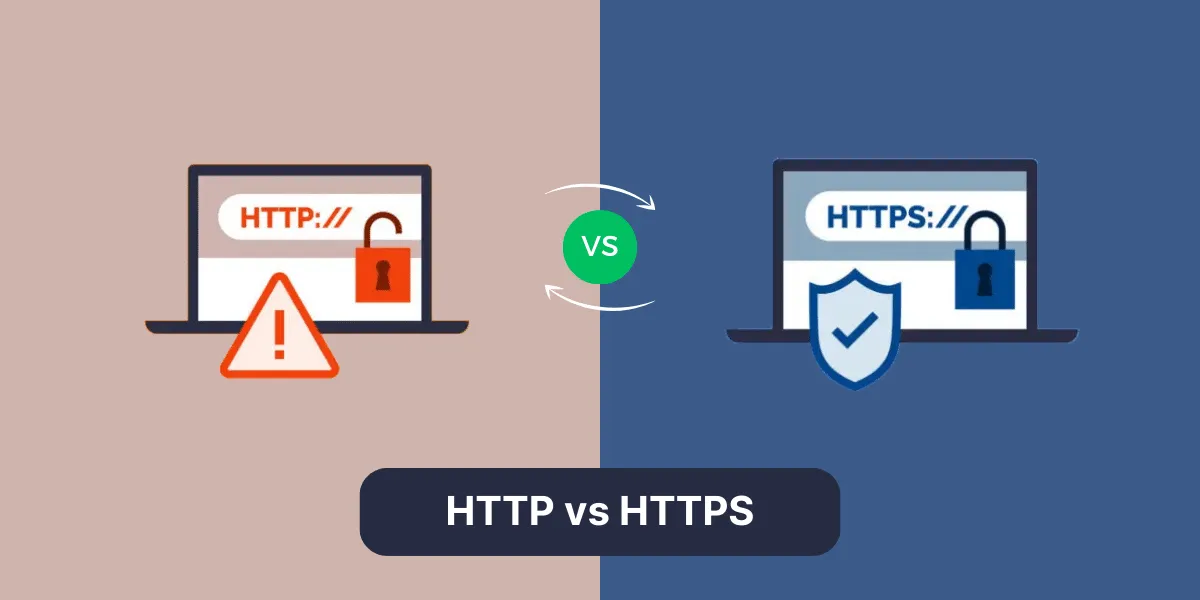Difference between http:// and https
The Hypertext Transfer Protocol (HTTP) and Hypertext Transfer Protocol Secure (HTTPS) are communication protocols used to transfer data between a web browser and a web server. While both protocols serve the same purpose, there are some key differences between HTTP and HTTPS that impact performance and security.
HTTP and HTTPS represent the foundation of data communication on the internet. When you access a website, your web browser sends a request to the server hosting that site. The server then sends back the requested information, such as text, images, video files, etc. This request-response cycle allows you to view websites and use internet applications.
Both HTTP and HTTPS use this request-response system. However, HTTPS establishes an encrypted connection, while HTTP sends data in plaintext. The added security of HTTPS comes at the cost of slightly slower performance compared to unsecured HTTP.
Understanding the trade-offs between HTTP vs HTTPS allows developers and users to make informed decisions about when to use which protocol. The sections below go over the key differences, pros and cons, and performance impacts in detail.
Head-to-Head Comparison Between HTTP vs HTTPS
| Feature | HTTP | HTTPS |
| Encryption | No | Yes, uses TLS/SSL |
| Authentication | No | Yes, authenticates server and optionally clients too |
| Integrity Checks | No | Yes, data is protected from tampering |
| Privacy | No, data sent in plaintext | Yes, encrypted data is private |
| Security | Very low, no protections built-in | High, resistant to interception and tampering |
| Usage | Declining, only ~10% of traffic | Dominant protocol, carries ~90% of traffic |
| Default Port | 80 | 443 |
| Caching | Can cache and reuse unencrypted content | Encrypted content cannot be cached |
| HTTP/2 Support | No | Yes |
| Performance | Faster due to no encryption overhead | Slower by ~10-30ms higher latency and 5-15% lower throughput |
Key Differences Between HTTP and HTTPS
HTTP and HTTPS have the following main differences:
1. Encryption
The primary difference between the two protocols is that HTTPS uses encryption while HTTP sends data in plaintext.
With HTTP, the requests from client to server and responses from server to client are in plaintext. This means the traffic can be read by any parties that intercept it along the way.
HTTPS solves this problem by encrypting the data during transmission. Popular encryption methods used by HTTPS include:
- SSL (Secure Sockets Layer): Uses asymmetric public-private key encryption. The website has a private key to decrypt data sent by the client’s public key. Provides authentication and data privacy.
- TLS (Transport Layer Security): An upgraded version of SSL. Provides the same encryption capabilities but is lightweight and more efficient.
The encryption in HTTPS creates a secure tunnel protected from data theft and tampering.
2. Integrity
Along with encryption, HTTPS also provides better data integrity guarantees compared to HTTP.
Altering data in plaintext HTTP traffic is trivial. HTTPS prevents this using message authentication codes that verify if the contents have changed during transmission. Any changes will invalidate the message.
3. Authentication
HTTP is an unauthenticated protocol, meaning the client does not verify the server identity and vice versa.
HTTPS authenticates the server and sometimes the client as well. The authentication helps prevent man-in-the-middle (MITM) attacks where an entity poses as the intended server to intercept traffic.
With HTTPS, the server provides a digital certificate issued by a certificate authority (CA) like Let’s Encrypt or Comodo. The CA vouchsafes the server’s identity. The client verifies this certificate before establishing the encrypted HTTPS connection.
4. Privacy
Since HTTPS encrypts data and authenticates endpoints, it offers much stronger privacy protections relative to HTTP. There are no guarantees of privacy when using HTTP as the traffic is unencrypted and unauthenticated.
4. Security
HTTPS is far more secure overall compared to HTTP due to the encryption, integrity checks, and authentication mechanisms. HTTP has basically no security built into the protocol itself.
Any sensitive transactions, like ecommerce purchases, login pages, or account management interfaces, should use HTTPS to keep user data safe.
6. Usage
Initially, HTTP was far more widely used across the internet since it came first and did not have the performance overhead of encryption. However, driven by security concerns, major websites and applications have migrated to HTTPS by default over the past decade.
As of 2022, studies show that HTTPS carries around 90% of global internet traffic, while legacy HTTP accounts for less than 10% and continues to decline.
7. Port Numbers
HTTP traffic uses port 80 by default, while HTTPS uses port 443. This difference allows web servers to easily differentiate and direct HTTP vs HTTPS requests.
8. Protocol Overhead
HTTPS requires more processing power on the server side to encrypt data before sending it and decrypt it after receiving it. HTTP has minimal protocol overhead in comparison.
This translates to extra load on server resources for HTTPS compared to HTTP. The impact is more pronounced on underpowered servers or those handling high volumes of requests.
9. Caching
The plaintext nature of HTTP allows intermediate servers and CDNs to efficiently cache and serve frequently accessed static content. The encrypted HTTPS data cannot be cached in the same way.
This caching provides performance benefits for HTTP, whereas all HTTPS requests must be passed to the origin server.
Pros and Cons of HTTP vs. HTTPS
HTTP Pros
- Faster Performance: No encryption overhead leads to better response times and throughput.
- Easier Scaling: Caching static HTTP content reduces loads on the origin server.
- Backwards Compatibility: HTTP is supported by legacy clients and networks that may have issues with HTTPS.
HTTP Cons
- Not Secure: Transmits data in plaintext that can be intercepted and modified in transit.
- No Encryption: Provides no protection of sensitive user data like account credentials or financial information.
- Vulnerable to MITM Attacks: Unauthenticated connections are vulnerable to attacks that intercept traffic by impersonating the server.
- No Integrity Checks: Cannot detect if data has been tampered with between client and server.
HTTPS Pros
- Encrypted Connections: Applies TLS/SSL to encrypt traffic and prevent data leakage.
- Data Integrity: Message authentication codes detect changes to data in transit.
- Server Authentication: Validates server identity to prevent MITM attacks.
- User Privacy: Encrypted traffic protects user data like credentials, personal info, etc.
- Secure Transactions: Essential for any exchange of sensitive data like payments.
HTTPS Cons
- Slower Performance: Encryption and decryption require additional resources which impact response times.
- Difficulty with Caching: Encrypted content cannot be cached by intermediate servers.
- Complexity: Certificate management and renewal introduces operational overhead.
- Compatibility Issues: Some legacy networks and clients may not fully support HTTPS.
When to Use HTTP
Despite the security risks, HTTP still has valid use cases:
- Sites and apps where no sensitive data is being transmitted. For example, a simple marketing website with only public info.
- Internal networks and tools with restricted access, assuming they are properly firewall-ed and segmented from external access.
- IoT devices that only exchange non-critical telemetry data and have hardware limitations that preclude HTTPS support.
- Initial phases of development before HTTPS are implemented.
- Redirecting from HTTP to HTTPS (see next section).
But in general, websites and applications should adopt HTTPS by default wherever possible. The minor performance hit is worth the sizable security and privacy gains for most modern use cases involving any type of personal data.
When to Use HTTPS
Here are some cases where HTTPS is strongly recommended or outright required:
- Public websites and applications, especially those handling user accounts, emails, documents, etc. HTTPS prevents leakage of personal data.
- Ecommerce sites and payment gateways need HTTPS to secure financial transactions and customer information.
- Cloud apps and services that transmit large volumes of confidential business data.
- Login and authentication pages should always use HTTPS. Sending credentials over HTTP is highly insecure.
- Web services and APIs that get integrated into other apps with sensitive data flows.
- Healthcare, government, and financial sites handling regulated data have mandated HTTPS usage.
- Any resource allowing users to input or access private information like social security numbers, medical history, bank accounts, etc.
HTTP to HTTPS Redirects
A best practice is to redirect all HTTP requests to HTTPS to force encryption by default. This redirect can happen at the web server level or application level.
Here is how to set up HTTP to HTTPS redirects:
- Web Server: The web server (e.g. Nginx, Apache) can directly redirect incoming HTTP requests to HTTPS via a rewrite rule. This ensures a secure connection before the request hits the application code.
- Application Code: Within the application itself, check if the request scheme is HTTP. If so, trigger a redirect to the HTTPS version of the URL before executing any other logic.
- Load Balancer: For cloud-hosted apps, the load balancer can redirect HTTP to HTTPS before proxying requests to the backend. This avoids exposing HTTP access at all.
- CDN Rules: CDNs like Cloudflare also allow setting rewrite policies to redirect HTTP traffic to HTTPS at the edge.
Ranking Factors for HTTP vs HTTPS Sites
The HTTP vs HTTPS distinction has an impact on search engine ranking factors:
- Google Ranking: Google search treats HTTPS as a positive ranking signal and gives a slight boost to secure HTTPS sites over equivalent HTTP sites.
- Browser Warnings: Chrome, Firefox, Safari, and other browsers show warnings on HTTP pages with forms, like login screens. This negatively impacts user experience which can in turn lower rankings.
- HTTP/2 Support: The updated HTTP/2 protocol is only available over HTTPS connections and can improve performance. HTTP sites miss out on these speed gains.
Migrating to HTTPS improves SEO rankings and prevents browser warnings. Adopting HTTP/2 also allows websites to benefit from performance enhancements like:
- Multiplexing: Allows multiple requests over a single TCP connection, removing header overhead.
- Server Push: Servers can preemptively send resources to clients without waiting for requests.
- Compression: Compresses headers for minimal data transfers.
- Prioritization: Clients can specify resource priority to optimize load order.
Measuring HTTP vs. HTTPS Performance Differences
Since HTTPS uses encryption and HTTPS does not, it inevitably requires more processing overhead that impacts response times and latency. However, with improving hardware and optimization techniques, this performance gap between HTTP vs HTTPS continues to shrink.
Let’s go through some key performance metrics and how the HTTP vs. HTTPS distinction affects them:
Latency
Latency measures the time required for data to transit networks between the client and server. Encryption and decryption requirements in HTTPS naturally add a bit of lag versus unencrypted HTTP requests.
With modern high-speed internet connections and efficient TLS implementations, this latency overhead is often negligible: as low as 10-20 milliseconds. Simple HTTP requests may have a head start of only 0.01 seconds compared to HTTPS.
For assets like images, scripts and video, 10-30ms higher latency is rarely a perceptible difference. But for workloads involving many rapid interactions or real-time communication, those milliseconds can quickly add up.
Throughput
Throughput indicates the amount of data transferred per unit of time. HTTPS throughput is generally 5-10% lower than plain HTTP because of encryption-related processing.
That said, many websites today are bottlenecked by network capacity or server resources, not by HTTPS throughput limits. Improving these other factors can offset any differences in throughput between HTTP and HTTPS delivery.
Page load times
Page load time measures how long it takes for a complete webpage to render in the user’s browser. With HTTPS, page loads are impacted by:
- Slightly higher latency for each request.
- Marginally lower throughput, especially for larger resources like images and videos.
- Potential for more round trips if resources need renegotiation of an encrypted session.
Altogether, published studies measuring real-world webpage loading over HTTP vs. HTTPS show the difference is less than 500 milliseconds on average.
While measurable, an extra half second delay on page loads is rarely perceptible to users. Factors like server response times, network congestion, and client device performance play a much bigger role in overall load times.
Concurrent connections
Due to the TLS handshake to establish encryption, HTTPS may have issues sustaining as many concurrent connections as plaintext HTTP. This can negatively impact performance on high-traffic sites.
One mitigation is to reuse HTTPS connections rather than repeatedly creating new ones. HTTP/2 allows multiple requests to share one connection, improving concurrency. Load balancers and reverse proxies can also maintain an open HTTPS connection instead of clients.
Caching
The inability to cache encrypted content is one of the biggest performance downsides of HTTPS relative to HTTP. Repeated HTTPS requests always have to hit the origin server.
Effective caching of static resources can significantly speed up HTTP performance. However, security should take priority over caching benefits for websites with sensitive user data.
Solutions like TLS session caches and database caching of query results help recover some of the HTTPS caching penalty.
Optimizing HTTPS Performance
Given that HTTPS introduces measurable overhead, what techniques help restore performance parity between HTTP vs HTTPS deployments?
Server Hardware
Invest in server specs: Faster processors and more cores can compensate for encryption overhead through brute force. Accelerator cards specifically for TLS offloading also help.
Enable compression: Compressing HTTPS traffic reduces transfer volumes which improves throughput and page load times. HTTP/2 compresses headers by default.
Increase bandwidth: Higher internet bandwidth reduces the impact of latency and throughput differences.
Caching and Load Balancing
Implement request collapsing: Collapsing duplicate requests into a single cached response boosts efficiency.
Set up a reverse proxy cache: A proxy server like Varnish can cache HTTPS responses and serve those before requests hit backends.
Distribute requests: Adding load balancers and CDNs spreads out HTTPS overhead across more servers.
Optimize caching headers -Fine tuning cache expiry times through headers ensures frequently needed resources stay cached.
Client Optimization
Minimize redirects: Eliminate unnecessary HTTP > HTTPS redirects which incur more round trips.
Reduce resource sizes: Smaller file sizes for images, scripts, etc. are less impacted by encryption throughput reductions.
Asynchronous loading: Fetching scripts and assets asynchronously avoids blocking page rendering.
Shard domains: Breaking up page content across multiple domains allows more concurrent connections.
Compress and minify: Reducing page weight with compression and minification offsets TLS bandwidth reductions.
Enable HTTP/2: All clients should use HTTP/2 over HTTPS for the best performance.
With well-architected infrastructure, optimized clients, and efficient protocols like HTTP/2, the real-world performance differences between HTTP vs HTTPS diminish considerably.
Frequently Asked Questions on HTTP vs HTTPS
Is HTTPS really needed for my website?
For any public website collecting or transmitting private user data, HTTPS should be considered a mandatory security measure, not an optional extra. The threats posed by unencrypted HTTP traffic are too significant to ignore.
Doesn’t HTTPS impact SEO?
On the contrary, switching to HTTPS typically improves SEO through positive signals in Google’s ranking algorithm and avoiding browser warnings on HTTP sites. The performance differences are negligible from an SEO standpoint.
How much slower is HTTPS than HTTP?
Research measuring real-world performance suggests HTTPS adds roughly 10-30ms higher latency and 5-15% reduced throughput versus HTTP. This holds page load times back by 500ms or less. With optimizations, the gap can shrink even further.
Is HTTP faster than HTTPS for image and file transfers?
Yes, HTTP will outpace HTTPS for transfer of large assets due to the encryption overhead. But the difference is usually measured in milliseconds and is unlikely to impact user experience.
Can I use HTTP and HTTPS on the same site?
It’s possible but not advisable. Supporting both protocols splits security across the site, leaving parts of the traffic unprotected. Mixed content warnings may also be triggered. Use redirects or rewrites to unify your site on HTTPS only.
Are there alternatives to HTTPS for better performance?
Some alternatives like Facebook’s Zero protocol remove TLS handshake overhead by establishing persistent encrypted connections. However, HTTPS remains the standard for public web traffic needing end-to-end security.



